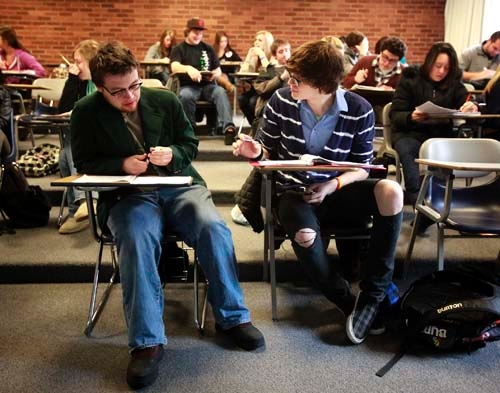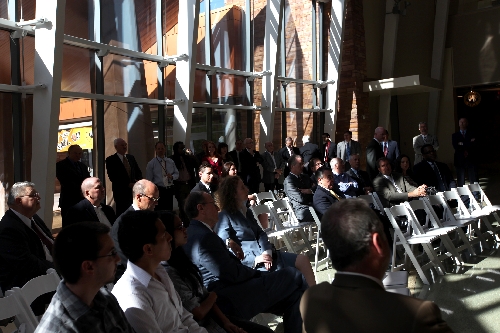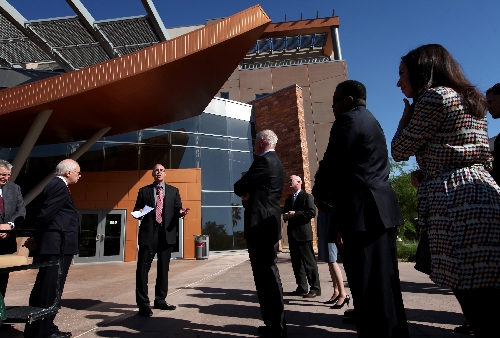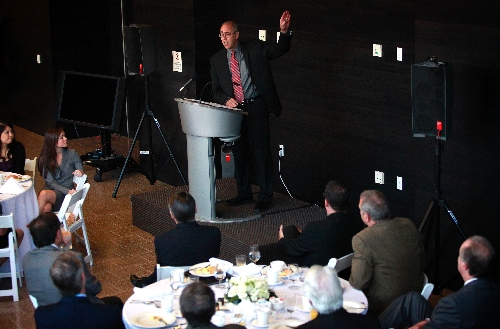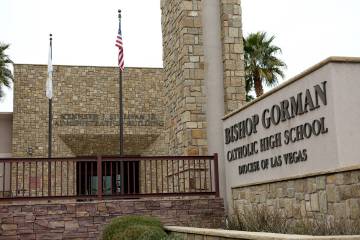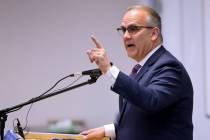Higher education may be taking Limited Choices 101
When Don Snyder took over as dean of UNLV's highly regarded hotel college a year ago, he came in with a few ideas.
Snyder is no academic. He's a businessman, former top boss at First Interstate Bank and Boyd Gaming, among other things. He knew, of course, that the university had been dealing with state budget cuts for a couple of years already. And he knew more would be coming.
So, he gave that some thought. What would I do, he wondered, if my business were in the same position?
Snyder's answer: He'd look at what the business's most important functions were, at what it did best. And he'd eliminate everything else if he could.
That's what he set out to do at the William F. Harrah College of Hotel Administration, the premier college at the university, insofar as reputation goes. Consulting with faculty, he launched a review of everything. The aim wasn't to save money. Not yet. The point was to make the college better, albeit probably smaller.
"It basically allowed us to step back for a minute, talk about what makes sense in a strategic sense," he said. "The numbers would come next."
The review revealed a few things, most notably a fairly large expansion of the college in the last decade.
Previously, the college offered one bachelor of science degree in a single major, with the choice of a few minors. But in 2004, the college began offering four different bachelor's degrees in nine different majors.
That kind of expansion, Snyder thought, weakened the college's focus on its core areas.
He asked around in the business community, too. Is specialization what you want from our graduates? Or is a more broad education better?
The latter won out.
"Almost universally, we heard from the employers that they'd rather have a more broad-based hospitality education," he said. "And then they could provide more specialized training later on if necessary."
Snyder then proposed eliminating all but a single degree, in hospitality management, but keeping four areas of concentration. Two good programs would be gone: sports management and a minor in entertainment. They simply weren't necessary, in Snyder's view.
Faculty would also be asked to work a little harder, and some electives would be eliminated.
BUDGET BATTLE
Whether any of his proposals happen will depend largely on what lawmakers do as they try to craft a state budget that takes into account a drastic drop in tax revenues.
Education is an obvious target. Higher education, in particular, takes up about 15 percent of Nevada's general fund spending.
But so far, all the state's higher education officials have to go on is Gov. Brian Sandoval's proposed budget for the next two fiscal years, which includes huge cuts across state government and no tax increases. The Legislature has yet to act.
His budget cuts current state support to higher education by $92 million for next year and by $162 million the following year, when compared to this year.
Reacting to forecasts of more revenue for the state than previously expected, Sandoval last week proposed reducing those cuts to the higher education system by $20 million over the two years.
Higher education leaders say that is not enough. They say another $60 million in funding is necessary.
Democrats presented an alternative plan last week, too, proposing cuts less than half the size of the governor's.
Sandoval's original proposal would mean a $47.5 million cut to UNLV over the next two fiscal years, on top of about $50 million in cuts in state support in the last four years.
To deal with the proposed cuts, higher education leaders are considering a host of options, including combining the northern community colleges into one unit, merging the Desert Research Institute into the two universities, and merging Nevada State College into UNLV or the College of Southern Nevada.
Some or all or none of that might happen, though, so UNLV officials must plan for the worst.
When the cuts began in 2007, both the University of Nevada, Las Vegas and the University of Nevada, Reno, largely trimmed across the board. Administrative positions were left open, and retirements were encouraged. Routine maintenance was postponed.
As more cuts came, class sizes were increased. Some salaries were cut, while workloads were increased for others. Tuition and fees increased systemwide, and some expensive programs were allowed to double or even triple student fees. The number of class sections began to shrink.
When even more state cuts came, across-the-board reductions -- known as horizontal cuts -- would no longer be enough at the two universities. Such cuts were viewed as weakening the entire institutions, according to UNLV's chief academic officer, Provost Michael Bowers, and they promoted mediocrity.
A program review was launched, with faculty, staff and students discussing what programs could be eliminated through specific -- or vertical -- cuts.
In the end, several smaller, usually expensive programs were axed.
And then, this past January, the governor presented his proposed budget.
FEWER CLASSES
Quickly, college and university officials across the state had to come up with plans. The reason was two-fold. Officials had to prepare if the proposed cuts became reality, and they had to tell lawmakers what the cuts would do.
Tuition and student fees will probably increase.
Right now, it costs a full-time student from Nevada about $2,500 per semester in fees -- not including books or special course fees -- to attend either university. Higher education leaders are proposing a 13 percent increase next year and another 13 percent increase the year after that. That is projected to raise $72 million in extra revenue over the next two fiscal years.
Traditionally, Nevada has had very low student tuition and fees. On top of fees that have already increased nearly 50 percent in the last three years, however, this new increase would bring Nevada near the regional median in student fees.
Nevada's universities, community colleges and the state college plan to handle some of the cuts horizontally, trimming budgets across their institutions. Generally, that will mean fewer classes offered by fewer professors and instructors.
Estimates systemwide say as many as 19,000 students will be turned away, either because there is no room for them or because they will no longer be able to afford the higher tuition and fees.
Officials are also planning a 5 percent across-the-board salary cut, replacing mandatory unpaid furloughs, which save 4.6 percent. The increased cut is estimated to save an extra $14.2 million over two years.
But these moves will still require millions in cuts at the universities. Both UNLV and UNR have proposed eliminating dozens of programs and laying off hundreds of staff and faculty.
UNR plans on cutting $58.8 million under Sandoval's budget. That's a larger cut than UNLV's -- $47.5 million -- mainly because UNR is more expensive to taxpayers per student than UNLV.
UNR is the most expensive higher education institution in the state for taxpayers, topping $11,000 in general fund support per full-time student last year. UNLV cost a bit more than $7,000 in general fund support per full-time student.
To save the $58.8 million, UNR officials have proposed eliminating two of its colleges by combining them with other colleges, and axing nine academic departments or units. In all, that will directly affect 1,600 students.
The plan calls for the elimination of 318 jobs -- 209 of them currently filled. Of the 318, 180 of them are faculty positions. Those plans are only preliminary, however, and are constantly in flux.
It remains unclear how the universities will be able to lay off tenured faculty. If that happens, there could be legal challenges.
In a letter to the campus announcing the plan last month, UNR President Milton Glick said the cuts "dramatically reduce the quality of the university's core instructional and research capabilities."
Glick died less than two weeks later of a massive stroke. The university's provost, Mark Johnson, has been named interim president.
On the cut list at UNR are several education programs, nutrition, philosophy, French, theatre and dance. Twenty other programs or divisions at UNR will see their budgets cut sharply.
Nine entities at the university would lose all their state funding under Glick's proposal and would have to raise enough money on their own to continue. Among them are the Center for Justice Studies, the Latino Research Center and the Child and Family Research Center.
Glick said it could take decades, if the cuts go through, for the university to regain the "quality and momentum" it was losing.
The university's enrollment grew more than 30 percent in the last decade, topping 17,000 last fall. Its budget grew even faster, with a 73 percent increase in state general funds between 2000 and 2010.
'DIFFERENT PATHS'
UNLV's announced budget cutting plans are similar to UNR's. UNLV President Neal Smatresk has announced cuts that would eliminate 36 different degree programs, including philosophy, social work, women's studies and environmental geology.
More than 2,000 students would be directly affected -- meaning their departments would be eliminated. There would be 333 full-time jobs cut, 191 of them currently filled. Of the 333, 136 are faculty positions. Again, though, the plans are preliminary and will likely be changed.
In the days and weeks after these cuts were announced, Smatresk often sounded in public appearances as if they were far from set in stone. And, it's true that many would not have to happen if lawmakers lessen the blow to higher education by making larger cuts elsewhere or by increasing taxes.
"There are many different paths this budget may take," Smatresk told a somewhat angry gathering of faculty at a March faculty senate meeting.
Faculty were upset that they had not been consulted as much and as deeply as they had been in past program elimination discussions.
"We don't know what the budget cuts we receive are and we don't know when we will receive them," Smatresk said.
He said there was very little time to come up with the plans, and stressed that they were subject to change.
Soon thereafter, Smatresk began to meet with deans of all 13 colleges at the university. He told them to revamp the cutting plans, talk with the faculty and start from the ground up. Reassess everything you do, he said, as if you were trying to make your college better, not just cut the budget.
He told them, in essence, to do what Don Snyder had begun to do at the hotel college.
Smatresk began talking a new game, saying that UNLV was a good university, of average quality, that needed to be better.
He told a gathering of business executives at a recent get-to-know-you session, for example, that "cuts can help us." He qualified that by adding that deep cuts would reduce the quality of UNLV and hurt its production of new graduates.
But it was clear that he had adjusted his public message about cuts.
Smatresk laid out for the executives, and in an interview, what he believed had happened at UNLV.
PERMANENT CHANGES
He said the university, like the community it sits in, had expanded very rapidly in recent decades.
Its budget shows that expansion. State general fund support to UNLV more than doubled from 2000 to 2010, while its enrollment grew by about 22 percent. (Enrollment has hovered between 27,000 and 28,000 the last three years, when the cuts started.)
It's natural during such a rapid expansion, Smatresk said, for new things to be added. A new program would become a new major, which would become a new department, which would require a department chair and a staff.
That can work as long as the funding keeps coming. It broadens the university's educational role, and can allow it to graduate more students over the long haul. More research is done in those new areas, expanding the region's economy. More jobs are created, and there are more opportunities for graduate students to get a solid education.
But when there are budget cuts, he said, the money can be stretched too thin.
"In a world of diminishing state support, do you hang on to your old trajectory, or do you change it?" he asked.
You are forced to change it, he said.
"We have to appreciate what's happening as a permanent change," he said. The old way of doing things will be impossible, he said.
Programs will be eliminated, which will save money, largely by eliminating employees.
In the hotel college, for example, Snyder's plan to eliminate two programs will also eliminate six faculty members. They'll be laid off.
His plans to increase workload and generally tighten things up will eliminate another four positions. He said he expects regular attrition to take care of those positions.
Overall, the plan would save about $1.5 million in the college, mostly through cutting 10 faculty positions. But Snyder said it won't hurt the college's core mission.
That's what Smatresk wants to see university-wide. He and Bowers, the provost, told deans and faculty to focus on their college's core areas.
What are they doing very well? What is critical?
They should determine if programs outside those core missions could be eliminated.
Smatresk said the merger of colleges is possible, too.
Bowers last week sent a letter to the campus explaining that deans submitted revised cutting plans based on more intensive consultation with the faculty.
"I don't know how well all of this will work," Smatresk said. "But I know if it doesn't start with the faculty, it won't work."
Faculty members have generally been supportive of Smatresk during the cutting process, both since he became president in 2009, and before that when he was provost.
Early in this round of cuts, there was some concern that faculty had not been sufficiently included, but Smatresk's new approach hits some key points that some faculty leaders have sought.
Gregory Brown, president of UNLV's chapter of the Nevada Faculty Alliance, has said both the state higher education system and the university should consider mergers and consolidations before simply eliminating programs.
Brown, a history professor, said he is glad UNLV is looking at the structure of its colleges, though it is far too early to judge the end results.
"Keep in mind," he said, "this is a process that's still largely uncharted."
He said such large budget cutting is rare in higher education, so there are not many examples to follow.
He also cautioned that while it is not easy to cut in a business-oriented college like the hotel college, it is probably not as difficult as it will be in less career-oriented disciplines like the liberal arts, which has more than the single mission of training people for the work force.
Regardless of specific programs eliminated, or how many, there will be consequences for students, even if they are not in those programs.
ENROLLMENT DECLINE
In addition to the pay cuts and the large tuition and fee increases, UNLV's enrollment will probably drop. Smatresk said the university will have to prioritize who can enroll, and it may have to turn away students who want to transfer from community colleges. There simply won't be room for them.
Kyle George, president of the Nevada Student Alliance, a coalition of student governments from across the state, said students are concerned about the long-term consequences of the cuts.
Good faculty are leaving, tuition and fees are going up, classes are getting harder to get into, and "a whole generation" of potential students could be left behind .
"Even if we don't get any more cuts, we've already been wounded by these proposals," he said.
Both universities' reputations have been damaged by talk of eliminating the philosophy departments, and by talk of financial exigency, a move similar to bankruptcy. No decisions have been made regarding such a declaration, however.
"If, in the end, we become the laughingstock of higher education in this country, what value is a degree from UNLV?" George asked.
The students this year have been more active politically than in years past, staging a rally in Carson City that at one point that had more than 1,000 participants. They have been lobbying key lawmakers, and many students have testified before legislative committees.
But the alliance has refused to back a tuition increase, a departure from recent years during budget cuts.
George said the student group will not support more tuition and fee increases unless higher education receives more state funding.
"In the past, we've stepped up," he said of the student support for past fee increases, "and they (legislators) haven't. So this is the year where we take a stand."
He said he is still unsure about the seemingly new approach to cuts at UNLV.
"I don't know the answer to that," he said. "I don't know how to value one program over another program."
None of the proposals are expected to be enacted until a final budget is in from the Legislature and the governor, which might not happen until June.
Brown, the UNLV history professor, noted that there are still many unanswered questions.
"Everything is a moving target," he said. "We don't have any real sense of where this will end up."
Contact reporter Richard Lake at rlake@reviewjournal.com or 702-383-0307.
Editor's note: Gov. Brian Sandoval's budget proposes major cuts in funding for public schools and higher education. This series takes a closer look at those potential cuts, the effects they may have on students and how educators are preparing to deal with them.
AHEAD THIS WEEK
• Nevada State College could be killed outright or folded into another institution Monday
• Researchers at money-making Desert Research Institute to leave if it’s absorbed by UNLV or UNR Tuesday
• Impact of cuts at the College of Southern Nevada Wednesday



